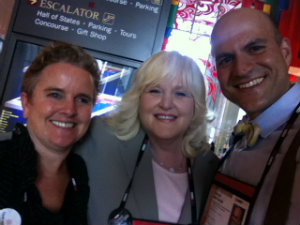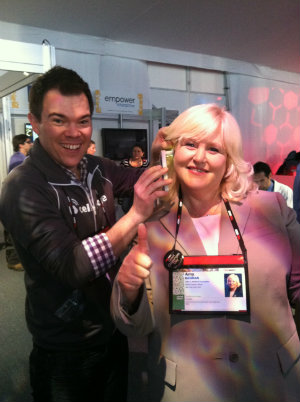 Amy Berman, left, with geriatrician and social media maven Wen Dombrowski at TEDMED 2013.
Amy Berman, left, with geriatrician and social media maven Wen Dombrowski at TEDMED 2013.Earlier this month, I attended my very first TEDMED in Washington, D.C. I had butterflies in my stomach because I was asked to provide opening remarks on the final day of TEDMED, at a convening on The Great Challenges of Health Care.
As a person living with serious illness, I was charged with speaking from the heart and grounding a discussion about the Role of the Patient. And as a professional who works on one of the biggest challenges health care faces—how to best care for a rapidly growing older adult population—excitement didn’t come close to describing how I felt. Thrilled? Terrified? Much closer.
What did I know about TEDMED—which describes itself as “a multi-disciplinary community of innovators and leaders who share a common determination to create a better future in health and medicine”—before going? I was already a huge fan. They are known for “Ideas Worth Spreading.” Having watched countless TEDMED talks on the internet, I expected brilliant speakers. In fact, TED stands for Technology, Entertainment and Design.
 Amy interacts with ONCHIT technology icons Farzad Mostashari, right, and Claudia Williams.
Amy interacts with ONCHIT technology icons Farzad Mostashari, right, and Claudia Williams.TEDMED brings these elements to the health care space, sparking discussion, innovation, and action through a diverse community of thought leaders. There were a wealth of TEDMED talks focused on aging issues, and they will be available for viewing at www.tedmed.com.
Here is a sampling of some of my favorite talks at TEDMED 2013:
What happens when patients become leaders on the health team?
America Bracho, director of Latino Health Access, described the real qualities of successful community health workers. I loved the abuela she used as an example—a grandmother in the community who helps others understand how to change their cooking to manage their diabetes. (America talked about chronic disease, culture, and disparity. She said the solutions will come from within communities and has achieved impressive results.)
When death is the enemy what is the victory?
Amanda Bennett, author of The Cost of Hope shared the story of her husband’s seven-year battle with cancer. (Amanda and I were honored together by the National Coalition for Cancer Survivors last year. She questions cost and value in cancer care.)
Can patient data have a second life?
Amy Abernethy, director of the Center for Learning Health Care at the Duke Research Institute, asked if we could donate our health data as safely and efficiently as blood. (Amy is a longtime friend, oncologist, and palliative care expert working to advance palliative care for those living with cancer, primarily older adults. She and I spoke at the Centers for Medicare and Medicaid Innovation’s Care Innovation Summit in 2012.)
How do we move from health data to health dialog?
Ryan Panchadsaram, senior advisor, White House Office of Science and Technology Policy, advocated for technology that makes better use of personal health information.
 Amy undergoes an ear exam via cell phone as part of her Smartphone Physical.
Amy undergoes an ear exam via cell phone as part of her Smartphone Physical.Aside from the TEDMED talks on center stage, there was The Hive. It was a space that showcased technology-enhanced innovations. The innovation community clearly recognized the aging demographic. At one booth—the Virtual Dementia Tour—I experienced what it is like to have dementia. My senses were altered using teaching aides on my eyes, ears, and hands, leaving me feeling confused and pushed with no idea what to do.
At another booth—the Smartphone Physical—I received a check-up via cell phone. This may make it possible for older adults with complex conditions to send readings and images in real time so they can be rapidly assessed and treated. By the way, not only were my ears healthy but they were the cleanest the doctor had seen.
The Hive was a space designed for TEDMED attendees to interact. And what a community! I met with health policy gurus Kavita Patel and former U.S. Department of Health and Human Services Assistant Secretary Glenna Crooks, ONCHIT technology icons Farzad Mostashari and Claudia Williams, Disruptive Women in Health Care founder Robin Strongin, and U.S. Surgeon General Regina Benjamin.
The most special of my days at TEDMED was Friday. The Great Challenges to Health Care sessions coalesced the TEDMED community around 20 topics. Participants included geriatrician and social media maven Wen Dombrowski, and the discussions took the community from concepts to an action plan.
 I advocated for the Role of the Patient. It was an honor to share my story and frame why we all have the greatest at stake, and can be the greatest advocates for our own good health. Yes, I talked about palliative care, advance directives, good communications, shared decision making, including the needs of the family—all important issues for people like me with serious illness as well older adults, who often face these same issues. The days started at 7 a.m. and ended close to midnight. Despite the exhaustion, I left wanting more—much more. I am now and forever a TEDMED member.
I advocated for the Role of the Patient. It was an honor to share my story and frame why we all have the greatest at stake, and can be the greatest advocates for our own good health. Yes, I talked about palliative care, advance directives, good communications, shared decision making, including the needs of the family—all important issues for people like me with serious illness as well older adults, who often face these same issues. The days started at 7 a.m. and ended close to midnight. Despite the exhaustion, I left wanting more—much more. I am now and forever a TEDMED member.
Special thanks go out to Team TEDMED—Jay Walker, Lisa Shufro, Shirley Bergin, and Witney Zatzkin—for raising issues and showcasing innovation central to our aging demographic.
